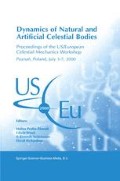Abstract
Satellites flying in formation is a concept being pursued by the Air U.S. Force and NASA. Potential periodic formation orbits have been identified using Hill’s (or Clohessy Wiltshire) equations. Unfortunately the gravitational perturbations destroy the periodicity of the orbits and control will be required to maintain the desired orbits. Since fuel will be one of the major factors limiting the system lifetime it is imperative that fuel consumption be minimized. To maximize lifetime we not only need to find those orbits which require minimum fuel we also need for each satellite to have equal fuel consumption and this average amount needs to be minimized. Thus, control of the system has to be addressed, not just control of each satellite. In this paper control of the individual satellites as well as the constellation is addressed from an astrodynamics perspective.
Access this chapter
Tax calculation will be finalised at checkout
Purchases are for personal use only
Preview
Unable to display preview. Download preview PDF.
References
Brouwer, D.: 1959, Solution of the problem of artificial satellite theory without drag’, Astronaut. J. 64 (1274), 378–397.
Carter, T. E.: 1998, State transition matrix for terminal rendezvous studies: brief survey and new example’, J. Guid. Navigat. Cont. 148–155.
Kapila, V., Sparks, A. G., Buffington, J. M. and Yan, Q.: 1999, ‘Spacecraft formation flying: dynamics and control’, In: Proceedings of the American Control Conference, San Diego, California, pp. 4137–4141.
Sedwick, R., Miller, D. and Kong, E.: 1999, ‘Mitigation of differential perturbations in clusters of formation flying satellites’, In: AAS/AIAA Space Flight Mechanics Meeting, Paper No. AAS 99–124.
Xing, G. Q., Parvez, S. A. and Folta, D.: 1999, ‘Implementation of autonomous GPS guidance and control for the spacecraft formation flying’, In: Proceedings of the American Control Conference, San Diego, California, pp. 4163–4167.
Author information
Authors and Affiliations
Editor information
Editors and Affiliations
Rights and permissions
Copyright information
© 2001 Springer Science+Business Media Dordrecht
About this paper
Cite this paper
Alfriend, K.T., Vadali, S.R., Schaub, H. (2001). Formation Flying Satellites: Control by an Astrodynamicist. In: Pretka-Ziomek, H., Wnuk, E., Seidelmann, P.K., Richardson, D.L. (eds) Dynamics of Natural and Artificial Celestial Bodies. Springer, Dordrecht. https://doi.org/10.1007/978-94-017-1327-6_7
Download citation
DOI: https://doi.org/10.1007/978-94-017-1327-6_7
Publisher Name: Springer, Dordrecht
Print ISBN: 978-90-481-5865-2
Online ISBN: 978-94-017-1327-6
eBook Packages: Springer Book Archive

